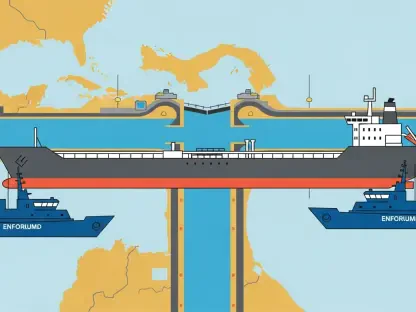As the United States grapples with the dual challenges of meeting escalating energy demands and achieving ambitious climate goals, a new legislative proposal has emerged to position bioenergy with carbon capture and storage (BECCS) as a cornerstone of national strategy. This innovative approach, which combines biomass energy production with carbon sequestration, is gaining traction as a potential game-changer in addressing pressing environmental and economic issues. Introduced by Representative Blake Moore of Utah, a House bill seeks to establish a federal commission within the Department of Agriculture to spearhead BECCS expansion. This initiative promises not only to curb greenhouse gas emissions but also to bolster rural economies and support the energy needs of cutting-edge technologies like artificial intelligence. Yet, with environmental concerns and policy hurdles looming large, the path forward remains fraught with complexity and debate.
Legislative Push for BECCS Integration
A New Federal Framework for Progress
The recent legislative effort to advance BECCS in the U.S. marks a significant step toward integrating this technology into the national energy landscape. Spearheaded by Representative Moore, the proposed bill envisions a dedicated commission under the Department of Agriculture, tasked with overseeing the development and deployment of BECCS projects. This body would bring together a diverse group of stakeholders, including federal land managers, energy officials, timber industry representatives, and rural community leaders. The collaborative approach aims to ensure that BECCS initiatives align with broader goals of energy security and climate mitigation. By focusing on converting forest biomass into energy while capturing and storing carbon underground, the framework seeks to address wildfire risks and provide a reliable power source. However, the success of this commission will depend on its ability to navigate competing interests and establish clear guidelines for implementation, a challenge that could define the future of BECCS in America.
Balancing Economic and Environmental Goals
While the proposed federal commission offers a structured path for BECCS growth, it must contend with the tension between economic benefits and environmental sustainability. Supporters argue that BECCS can revitalize rural economies by creating jobs in biomass harvesting and energy production, while also meeting the soaring energy demands of data centers and AI systems. Industry estimates suggest that this technology could contribute over 200 gigawatts of baseload power to the grid, positioning it as a vital asset for technological advancement. Yet, environmental groups remain skeptical, questioning whether large-scale biomass harvesting can truly be carbon neutral. Concerns about forest health and biodiversity loss loom large, with critics warning that overexploitation of natural resources could undermine climate benefits. Resolving these conflicting priorities will be critical for the commission as it seeks to craft policies that promote sustainable practices without stifling economic potential.
Global Context and Policy Challenges
Lessons from Europe’s BECCS Implementation
Examining the global landscape reveals a stark contrast between U.S. efforts and the more advanced BECCS initiatives in Europe, offering valuable insights for American policymakers. Countries like Sweden and the U.K. have moved beyond theoretical discussions to operational projects, with facilities such as Stockholm Exergi’s plant and trials at Drax power station demonstrating tangible results. These successes are underpinned by robust carbon pricing mechanisms and government subsidies, which provide certainty for investors and encourage widespread adoption. In contrast, U.S. policy relies heavily on tax credits, creating a less predictable environment for long-term investment. This disparity raises questions about whether the commission-heavy approach proposed in the House bill can replicate Europe’s achievements. Learning from international models could help refine domestic strategies, ensuring that BECCS becomes a viable component of the energy mix rather than a stalled experiment.
Navigating Domestic Policy Uncertainties
Beyond international comparisons, the U.S. faces unique domestic challenges in scaling BECCS, particularly in the realm of policy and stakeholder alignment. Industry advocates push for streamlined contracts to access biomass from federal lands, a move that could accelerate project timelines but risks opposition from conservationists concerned about ecological impacts. The debate over environmental sustainability remains unresolved, with no consensus on whether BECCS can deliver on its promise of carbon reduction without harming ecosystems. Additionally, the reliance on tax incentives rather than comprehensive subsidies introduces financial uncertainty for developers, potentially slowing momentum. The proposed federal commission must address these issues by fostering dialogue among diverse groups and crafting a policy framework that balances innovation with caution. Only through such efforts can BECCS emerge as a credible solution to the nation’s energy and climate challenges, avoiding the pitfalls of political gridlock.
Charting the Path Forward for Sustainable Energy
Building a Collaborative Future
Reflecting on the journey of BECCS in the U.S., it becomes evident that the legislative push through Representative Moore’s bill marks a pivotal moment in recognizing the technology’s potential. The establishment of a federal commission within the Department of Agriculture aims to provide structure, yet it encounters a complex web of environmental critiques and industry demands. The initiative seeks to harness forest biomass for energy while addressing wildfire risks, but debates over sustainability linger. Looking ahead, the next steps involve fostering greater collaboration among stakeholders to refine policies that support both economic growth and ecological integrity. Encouraging pilot projects with transparent monitoring could build trust and provide data to guide future decisions, ensuring that BECCS contributes meaningfully to national goals.
Innovating Beyond Current Barriers
As discussions around BECCS unfold, the need for innovative solutions to overcome existing barriers stands out as a critical takeaway from past efforts. Bridging the gap with Europe’s more advanced implementations requires exploring alternative funding models beyond tax credits, such as public-private partnerships. Addressing environmental concerns through stricter sustainability criteria and investing in research to minimize ecosystem impacts also emerge as priorities. Moving forward, policymakers should consider integrating BECCS into broader climate strategies, aligning it with renewable energy targets. By focusing on scalable, adaptable frameworks, the U.S. can position itself to leverage this technology effectively, turning past challenges into opportunities for a more resilient energy future.









